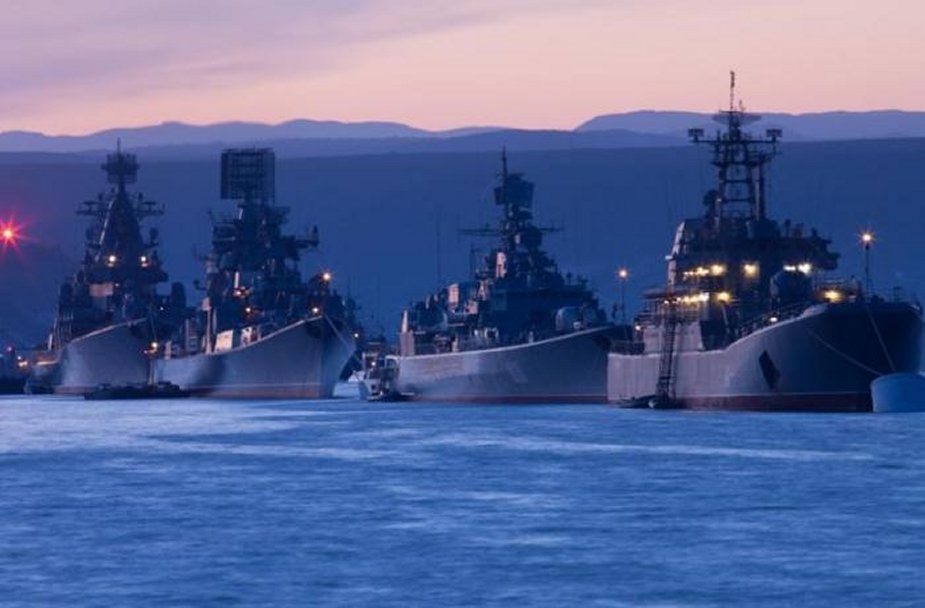The Russian Navy has to engage in a broad range of missions which determine its strength and composition. The Military-Industrial Courier advises which Navy Russia has to have due to the international situation and national development priorities. The Military-Industrial Courier has delivered what is seems to be the best distribution of the Russian ships among its different fleets.
 Some Russian vessels near to Syria (Picture source : AsiaNews)
Some Russian vessels near to Syria (Picture source : AsiaNews)
The Northern fleet has to have a group of 6-8 SSBN, 12-15 SSN, 8-9 SSGN and 15-20 diesel and non-nuclear submarines, 15-20 blue-water warships and up to 110 brown-water ships (30 attack, including missile boats, 30 antisubmarine ships and 50 minesweepers), up to 15 big landing ships, one naval, coastal, reconnaissance, antisubmarine and airlifter air regiment, helicopter regiment, a squadron of MiG-31K armed with Kinzhal missiles and of seaborne attack aircraft, a regiment of coastal missile artillery, and a regiment or battalion of marines.
The Pacific fleet has to have 15 SSN and 8-9 SSGN, 20-25 diesel and non-nuclear submarines, an aircraft carrier, 15-20 blue-water warships and up to 135 brown-water ships (35 attack, including missile boats, 40 antisubmarine and 60 minesweepers), 20-25 big landing ships, one regiment of naval, coastal, reconnaissance, antisubmarine and airlifter aviation, helicopter regiment, a squadron of MiG-31K armed with Kinzhal missiles and of seaborne attack aircraft, a regiment or battalion of marines, and two coastal missile artillery regiments.
The Baltic fleet needs 6-8 diesel and non-nuclear submarines, up to 20 brown-water attack warships, 20 antisubmarine and 40 minesweepers, 10-12 big and medium landing ships, a fighter jet regiment, squadrons of reconnaissance and antisubmarine aviation, antisubmarine and transport helicopter regiments, a squadron of naval attack aircraft, a marine battalion or regiment, and two regiments of coastal artillery missile troops.
The Black Sea fleet needs ten diesel and non-nuclear submarines, 30 brown-water attack ships and boats, 15-20 antisubmarine ships and 30 minesweepers, 7-10 big and medium landing ships, a fighter jet regiment, antisubmarine helicopter regiment and a transport helicopter squadron, a marine battalion and a regiment of coastal missile artillery troops.
The central force should have a division of seaborne missile aviation, one-two squadrons of blue and brown-water reconnaissance and antisubmarine aviation, naval attack aviation, a marine division and one-two regiments of coastal missile artillery. Besides, it is necessary to develop maritime space reconnaissance.
If compared to the current strength, the Navy lags 35-45 percent behind. The latest arms have not been supplied in sufficient number. Except for some units, big warships and submarines have not been modernized. A major part of operational fleet needs midlife or capital overhaul. Only the strength of SSBN meets the requirements.
In a big conflict with the navies of major countries (the USA and NATO in the west, the USA, Japan and allies in the east) the Russian Navy will be incapable of fulfilling all the missions. In local conflicts against weak naval powers the Navy can create the necessary force by engaging warships from all fleets. However, it would be difficult to maintain it for a long time because of a general shortage of operational warships.
As military tension mounts in the world, it is necessary to take urgent measures and increase Navy capabilities. The shipbuilding program envisages a rapid pace of reinforcing the Navy. However, it will hardly provide 60 percent of the required force. It is thus necessary to overhaul warships and raise the share of operational ones to 85-90 percent. The inherited Soviet arsenal meets modern requirements and the overhaul of Soviet warships even without major modernization will be an effective and cheap way to restore the combat capability of the Navy. Another important task is to mount the capabilities of naval reconnaissance aviation in green waters. At present is does not meet the requirements.
All these measures will help the Navy fully protect the Russian interests in the World Ocean. It is to be admitted that existing economic trends do not give grounds to expect the restoration of the Navy potential to the minimal necessary level in acceptable time, the Military-Industrial Courier writes.
© Copyright 2019 TASS. All rights reserved. This material may not be published, broadcast, rewritten or redistributed.










